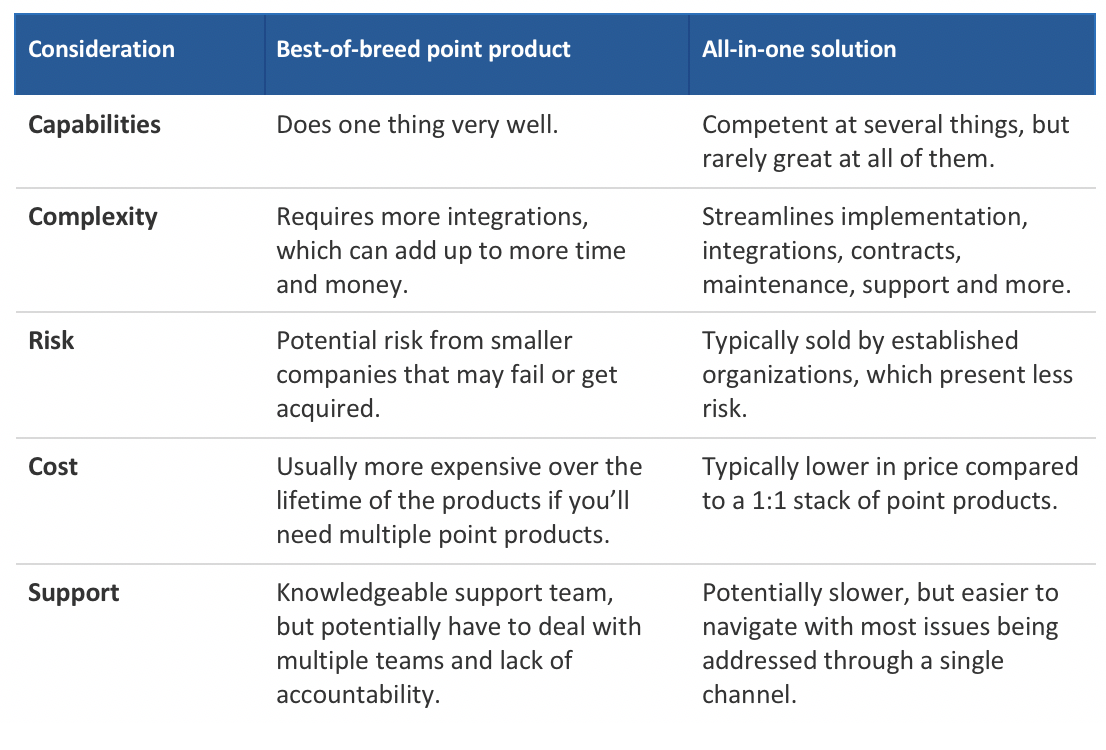Choosing the right technology to support your station’s operations and revenue objectives can be a complicated process. You must identify the capabilities needed to support your strategies, make a list of software that meets those requirements, then evaluate that list against a number of factors including features, timing, support, business risk, and of course, budget.
As part of this process, most companies take one of two approaches: best-of-breed or all-in-one. What’s the difference?
- Best-of-breed is a multi-vendor strategy in which the business selects the best product for each use case from different vendors. Ideally, each product excels at its category and plays nicely with other point products to build a stack that works together.
- A marketing department, for instance, would have separate products for functions like email marketing, content management, web analytics, social media, etc. that would integrate via APIs (software “messengers” that let two applications talk to each other). You can also think of the best-of-breed approach with a simple example like shopping for a new bike. If you wanted a really high-performing bicycle, you could research and buy the best of each part of the bike — frame, wheels, tires, handlebars — and put it together yourself.
- All-in-one is a single vendor strategy in which the business relies on an integrated platform from one provider to meet many or all of its use cases. Ideally, this approach cuts down on complexity across the product lifecycle, from procurement to implementation to integration to support and maintenance.
- The Salesforce Marketing Cloud is a good example, providing capabilities like email, social, mobile and digital advertising on top of its CRM foundation. Or in the bicycle example, an all-in-one platform would be the equivalent of buying a new bike “off the shelf” from a shop. It has all the parts you need to ride the bike, it will get you where you need to go, but each component won’t be the best of the best.
Most radio stations don’t need the breadth and depth of Salesforce, but may still face scenarios where the best-of-breed versus all-in-one decision applies, such as supporting cross-channel advertising. The “right” answer depends on the business and the software in question, and the right approach for one station may not be the same for another. Let’s look at five factors to consider when choosing between a single or multi-vendor approach.
1. Capabilities
Perhaps most importantly, what is the vendor capable of? Does it have the features and functionality necessary to support the business? Many organizations choose best-of-breed products because they are, by nature, really great at one particular thing. As a customer, a best-of-breed product would likely meet all of your requirements and then some, giving you room to grow.
The flip side is that you may not need all those bells and whistles, today or ever, in which case you’re paying for unnecessary functionality and complexity. A single-vendor platform may not be the best at everything, but may still provide the features that you need to get the job done.
– Best-of-breed: More and, in some cases, better capabilities that can support a specific use case for years to come. Software that does one thing very well. This is the core reason that companies choose best-of-breed solutions.
– All-in-one: An integrated platform can be competent at several things, but rarely great at all of them. Competent may be good enough, especially given other trade-offs.
2. Complexity
If organizations decide to use multiple vendors to achieve optimal performance in each area, they choose a single vendor to reduce complexity across the board. An all-in-one solution is simpler to install, requiring far fewer integrations, which accelerates time to value. Procurement is easier, with one contract and licensing agreement. User training often takes less time and fewer resources due to a consistent interface across product modules in the platform. Processes ranging from user login to data management become more efficient so people can be more productive.
Big ships, however, are harder to turn. Adopting one solution to meet multiple needs usually requires getting a number of stakeholders on board. It can take time to convince all relevant internal resources of the merit of a particular platform as well as put the pieces in place to deploy it, such as switching off existing products and ending current contracts.
– Best-of-breed: Definitely more complex, which can add more time and money. But APIs are changing that, reducing the integration burden between multiple point products.
– All-in-one: Reducing complexity is the core advantage of a single vendor strategy. Using a united platform streamlines implementation, integrations, contracts, maintenance, support and more.
3. Risk
Best-of-breed and all-in-one approaches involve different levels of risk. All-in-one solutions usually come from larger, more established vendors that will most likely stay in business and continue to support their products. Point product vendors, on the other hand, tend to be newer and/or leaner. Customers run the risk that the company will go under or get acquired, neither of which is a good outcome for an integral piece of your technology puzzle.
The established nature of platform providers does have its drawbacks, though. Large organizations tend to be less flexible, with a tighter ecosystem and longer contracts. For some customers, this leads to balancing the acquisition risk of a best-of-breed provider with the potential for vendor lock-in.
– Best-of-breed: Often comes from smaller companies that may fail or get acquired. Can be more flexible with pricing, contracts, and connections to other systems.
– All-in-one: Typically come from established organizations that are much less likely to go under or go away. Vendor lock-in can be a concern.
4. Cost
Budget is always a determining factor in software decisions. Depending on the size of the stack, a best-of-breed approach can add up quickly. While individual licenses may be less expensive than an all-in-one platform, each system must be implemented, integrated and supported for its lifetime. Users must be trained on each disparate tool as well, consuming additional time and resources.
All-in-one platforms offer economies of scale. While one platform will likely be more expensive than one or two point products, it will be more cost-effective than bringing on three or more. It must only be implemented and integrated with existing infrastructure once and is only one contract to negotiate. Buyers should consider, however, whether they actually need everything included in the suite. If you only need two of the five capabilities, it becomes a less compelling deal.
– Best-of-breed: Usually more expensive over the lifetime of the products, assuming you truly need everything included in the all-in-one platform and must support those use cases independently.
– All-in-one: Typically lower in price compared to a 1:1 stack of point products, but customers can end up paying for functionality that they don’t need or use.
5. Support
Finally, best-of-breed and all-in-one models provide varying levels of support. Because best-of-breed vendors are highly specialized, their support teams tend to be real product experts with extensive knowledge and experience. The small size of point product providers can also make them more nimble and responsive to support requests.
On the other hand, using multiple vendors means multiple support channels. Each tool will have its own support systems and processes to understand and follow, which can be difficult to navigate, especially with business-critical operations on the line. Supporting integrations between products can become tricky as well, with the potential for each vendor to “point the finger” at a different product in the stack when issues arise.
With a single vendor of an all-in-one solution, the trade-offs are reversed. Support personnel may not be as seasoned in every nuance of the platform. Customers may also experience more “red tape” when working with a larger organization, potentially resulting in longer resolution times. Any and all issues, however, can be addressed through a single channel: one process to learn, one phone call to make, one set of relationships to build. Supporting an all-in-one platform eliminates finger-pointing as well; with far fewer integrations, issues are less likely to get punted to another vendor.
Best-of-breed product versus all-in-one platform

The net-net? The best approach for your business depends on your requirements, timeline, budget, risk tolerance and more. At Marketron, we support both models and work closely with our clients to determine the best fit for them. From NXT, our revenue management platform that allows radio stations to manage digital and radio ad campaigns in one place, to our multiple best-in-class point products such as Pitch, an advanced digital ad platform and our radio traffic management product suite, we believe that the right strategy is the one that works best for you.






